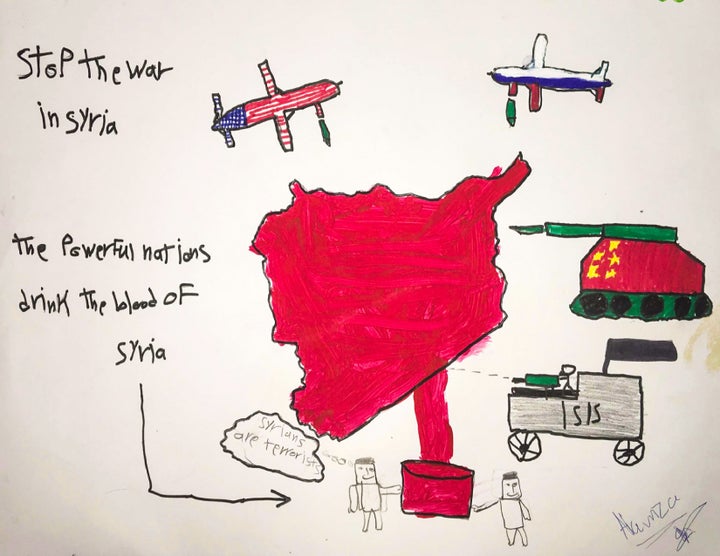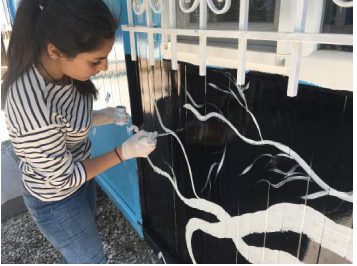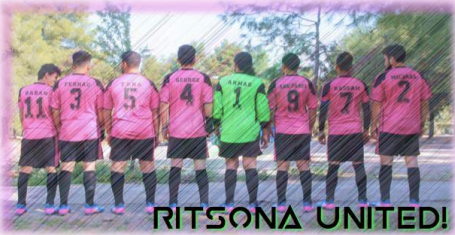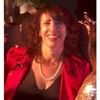The Ritsona Kingdom Journal captures the heart and home of young refugees

Pictured: The cover art for The Ristona Kingdom Journal second edition, by Hamza Almustafah.
The feelings and images that flood our consciousness when we see young Syrian refugees are misery and pain; a dead child on a sandy beach or millions stacked into camps along the borders of countries most of us will never see and cannot even find on a map. Yet, like a flower growing out of the carnage of war in a small corner of one refugee camp, 16-year old Hamza Almustafah is creating powerful works of art like “Stop the War in Syria” and “Letter to the UN” that strike at the heart of the conflict that surrounds him, day in and day out.
In his home in Greece’s Ritsona Refugee Camp, Hamza is part of a truly remarkable artistic phenomenon, a powerful version of arts activism, in the form of a publication. The Ritsona Kingdom Journal is that publication—started by a group of passionate human rights activists and young refugees convinced that if they share their story, they too can help change the narrative of this endless conflict.
From this journal, the world receives an opportunity to examine the role of the artist during a time of war, and the chance to explore the transcendent nature of art and how it can show us the exemplary beauty of daily life, while simultaneously cutting through the everyday noise, hype, politics and cultural differences to highlight the current issues of the day.
Even given their own experiences, the youth of Ritsona are sharing feelings and grappling with the most recent issues facing our world. The current edition addresses, among other topics, the victims of the recent Barcelona terror attack, with many of the youth calling out to victims and their families to offer a message of hope and solidarity. These messages are particularly powerful, as they come from those individuals that not only endured absolute terror, but are often maligned as the source of terror.
It is my opinion that it is essential for artists to think beyond the strict boundaries of critical thought and test the limits of what is possible—and dare to challenge our norms and our beliefs. This is what The Ritsona Kingdom Journal is actively engaged in and is what inspired me to share their story. Just as the youth of Ritsona offer a powerful vision and opportunity for solidarity across borders and cultures, I hope that by sharing their phenomenal effort, a broader world of solidarity and connections will be opened and strengthened for them.
The stories and insights shared by young refugees in Ritsona are critical to a world that grapples with a global refugee crisis, and at the same time, struggles to differentiate between victim and villain. As so many of the Ritsona youth participants escaped nations that are associated with the stamp of terror, they face the double-edged sword of being truly victimized and also unfairly villainized by many, due to their ethnicity and country of origin.

Pictured: A Youth Ritsona arts workshop in the new Youth Engagement Space (YES).
Within these pages are not just the stories of refugees, but also their perspectives on current events, and their remarkable statements of solidarity with a world that has become overwhelmed with division.
Farhad Rashid, a 21-year old Ritsona youth and writer from Aleppo, shared that “...terrorists did the same thing in our country. It doesn’t matter where they are from and where they live. They are just terrorists….There are racist people and terrorists everywhere.”
Hamza Almustafa, himself from Salamiyah in Syria, wrote that “I wanted to send my condolences to the Spanish people, we know how they feel because we had a lot of attacks in Syria. Some people in Europe think we are terrorists and killers, but we wanted to send a message that we are not terrorists, and in fact we escaped terrorists to save our lives.” In a separate August journal entry defining the term refugee, Mr. Almustafa wrote that “Refugees are normal people. In my opinion, there is no difference between colour or religion— we are all human...half the world doesn’t like us. Why? Do we look like killers? Look at our faces, at our pictures. Think about the things we want.”
With such poise, it’s easy to see what Hamza Almustafa is getting at. How it is important to see someone, not for how you think they are or how they may or may not be based on stereotypes or assumptions—but just as they are.
In this refugee camp and with this magazine, they are creating the rare example of art activism that is truly born through the struggles and experiences endured by the very people in the middle of some of the most intense conflicts in the world. For the most part, people in the middle of crises don’t have the opportunity or resources to create art, let alone to share it with a world often blind to the very serious struggles they face.
The Ritsona Kingdom Journal is one of those very rare exceptions. Since learning of the incredible program, I have been exploring the details and works of art that have come from Ritsona Youth within the Ritsona Refugee Camp in rural Greece.
In an interview with leadership at Lighthouse Relief, the NGO offering psychosocial support to the artists and writers behind The Ritsona Kingdom Journal. I learned that the journal itself was started by the young refugees, mostly those who have escaped the cruel daily horrors in Syria, as well as others from Iraqi and Kurdish lands. Through art and writing workshops called Youth Engagement Space (YES), refugees aged 16-25 have been documenting and processing their unique experiences, and the journal captures it all, showing an unedited and un-curated collection of what was produced in the camp workshops. The idea became more real as most young refugee children in Greece are excluded from the Greek school system, and so the experiences and difficulties they feel are presented in a cutting-edge vision of artistic social activism. The first journal was launched in April 2017, and in August, the third journal went live.
Browsing through the three volumes of The Ritsona Kingdom Journal, it isn’t difficult to understand the importance of this rare collection of a true and deeply misunderstood reality. Whether it's a drawing, a poem, a photo, story or installation, these works exemplify a strong range of emotions from courage and love to pain, hopefulness, and dread.
The humanizing impact and tangibility of such experiences invoked by the works captured within the journal address a profound gap in consciousness, when it comes to what life is really like for refugees, and who they really are. In the opening journal, youth writer Mustaffa Mustaffa artistically described life in Ritsona, in a most poetic and moving manner. He wrote, “Everything in this camp has become a story. We made the dirt speak of our suffering. The tents have become a tale. Love is a novel.”
The April edition has many emotionally jarring, uncomfortable statements about life in war-torn Syria, and then in contrast, on the opposite end of the spectrum, a section on creative jewelry making that has taken place in Ritsona, and a recipe for a cheese-filled pancake dish. The youth of Ritsona are not solely defined by their experience and status as refugees—they are also just young, hopeful people, who like to cook, do needlepoint, paint, draw, play football and make bracelets like youth from any nation in the world.

Pictured: Ritsona United FC, founded by Bassam Omar alongside La Asociación Amigos de Ritsona.
It is my hope that more leaders from around the world will have an opportunity to take in the stories and beautiful messages from children expressing themselves in an untarnished and transparent way. I think of how former President Obama captured this feeling in one statement: “In the faces of suffering families, our nation of immigrants sees ourselves.”
It would be a very powerful statement indeed if more people would be exposed to these works and truly understand the gap between the life of children and young adults as refugees and our global misunderstanding and actions toward them. Through The Ritsona Kingdom Journal, a new awareness and realism is being brought to life with a solid and compelling message.
